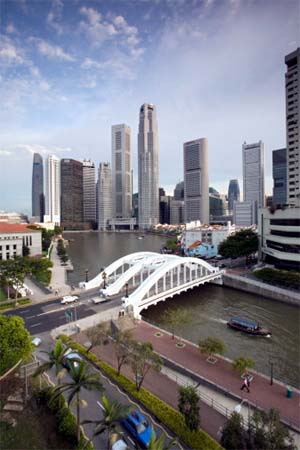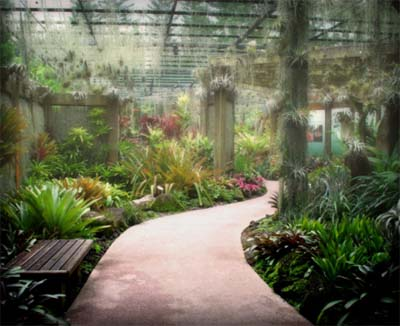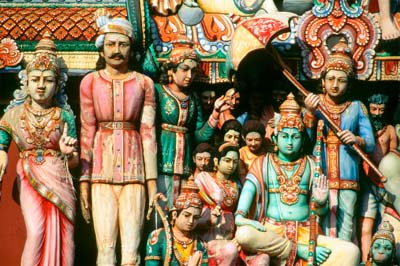Dec 17, 2025
Dec 17, 2025
 Singapore Skyline A week prior to my departure to Singapore I had been told by a friend that I should keep my expectations from the city low. The people in the city, he said, would be cold and unresponsive. The city, according to him, was all metal and glass and very expensive to boot.
Singapore Skyline A week prior to my departure to Singapore I had been told by a friend that I should keep my expectations from the city low. The people in the city, he said, would be cold and unresponsive. The city, according to him, was all metal and glass and very expensive to boot.
At 67 USD per night, the Copthorne Orchid, my hotel in Singapore was less than half of what I had paid in Dubai, and the accommodation turned out to be even more spacious. The city was certainly expensive but at least on the accommodation front I found it to be reasonable. At the airport when I hailed a taxi, I suddenly forgot the Copthorne part of the name of my hotel. The taxi driver shook his head. The orchid was the national flower of Singapore and there were more than a dozen hotels with the orchid suffix. Luckily, I remembered that my hotel was situated on Dunean Road; there was only one Orchid suffixed hotel there.
As Kim Lee, my English speaking Chinese taxi driver drove me through the city I saw that the metal and glass my friend has spoken of was certainly present in abundance, but there was also great deal of greenery all around. Tina, a friend’s friend, a Malaysian who worked in Singapore and showed me around told me that in the last ten years as a result of afforestation, the city’s temperature had dropped by one degree: this had translated in a saving of hundreds of thousands of dollars in terms of electricity and power requirements. I could well believe this.
 Botanical Gardens, Singapore
Botanical Gardens, Singapore
The Botanical Gardens are sprawled over acres and acres of territory, and you could easily spend a couple of days wandering inside if you were so inclined. Take care though that you don’t pluck a leaf from a tree, let alone a flower; this could be something you could be arrested for in Singapore.
By the way, for more serious offences they still have the practice of caning. Remember the American who was to be caned some years ago. This caning is no ordinary headmasters caning that an errant school boy might have, in years gone past, received in a British public school, but following just one administration of the stick by a professional caner, the ‘canee’ needs to be admitted to hospital. A sentence of three canings might therefore take one and a half years to administer.
Instances of such severity aside, did I find the people cold and unresponsive as my friend had warned me? Certainly they didn’t stand with folded hands in front of the elevator mouthing ‘Swadee Kha’, which had been the case at Baiyoke Sky Hotel, the hotel I had stayed at in Bangkok, but did I expect that kind of courtesy, subservience, call it what you will, in a much richer country – and more to the point did I even want that? Immigration was vastly more pleasant and professional than it had been in Dubai. Kim Lee the taxi driver was chatty, friendly, articulate and spoke such excellent English, that I felt compelled to try and persuade him to go back to University, get a degree and try and find a better vocation. And in my subsequent encounters with various people in the city, I did not find them to be unfriendly – at least not more so than you would expect to find in a metropolis. But perhaps it was beneficial for me to have arrived in this country with low expectations.
Singaporeans themselves do make some self-depreciating comments about their materialistic attitudes. Ling Chang, my tour guide spoke of how it’s very difficult for a Singaporean man to find a Singaporean lady for purposes of marriage. That’s because, she explained laughingly, the women are looking for five C’s in a potential matrimonial candidate: C for Cash, C for Credit Card, C for Car, C for Condominium and lastly C for Career. And for this reason the men nowadays prefer to sidestep demanding Singaporean to marry a Vietnamese or a Chinese from Malaysia or even mainland China.
There are tourist attractions being planned in Singapore, and prominent among these are Las Vegas style casinos. Massive construction is taking place a few hundred yards away from the famous Singapore Malion, the iconic half lion, half fish that belches out water from its mouth. The Government wants foreigners to come and lose their money. At the same time, in their paternalistic style of governance, they don’t want to create any social problems that may arise from gambling by Singaporeans themselves and so they have provided free entry for visitors to their country but for a Singaporean who wishes to enter the casino there will be a prohibitive hundred-dollar entry fee.
Singapore may earn money through tourist attractions such as the casino but it will thereby lose some of its charm for despite the metropolitan life style there still survives in parts of the city and in the overall experience a sense of quietness in a visitor’s experience of the city. Tourists must do the obligatory cable car journey or road trip to the Sentosha Island, but this place is to my mind at least is simply a money spinning highly touristy island – they don’t serve pork snacks out of respect for the money that their Middle Eastern tourists bring – that cannot compare with any of the beautiful islands of Malaysia, Thailand or Indonesia. It is far too commercialized. Even the famous Son et Lumiere, for all its incredible hi tech psychedelic presentation seemed rather too ‘Disneyland’ to me.
I reached Singapore just a few days before the Formula One race slated for September. At Clarke Quay there were boats running down the river, which charged sixty dollars or so, for a chance to catch a glimpse of the practice sessions. The cheapest tickets began at five hundred dollars apiece, but that was only part of the expense for enthusiasts who were flying down for the occasion. Some of the high-rise hotels in Singapore had rooms on the higher floors that provided a view of the race and they had upped up their rates accordingly.
I opted for the cheaper boat ride at eighteen dollars at ride that didn’t promise a glimpse of the practice sessions, but saw the glum faces of the passengers on the more expensive boat ride on their way back – the practice had been disappointing, I guessed. I heard the screaming of the tyres soon after embarking on the river cruise, and through much of the ride, so I can honestly say that I heard the F 1 rehearsals even if I didn’t see any!
Within Singapore I did find Serangoon Street to have a very interesting ambience and atmosphere. Crowded like a market in Tamil Nadu would be, the merchandise were labeled and stacked like they would be in shops there, but at the same time, patriotic sentiments apart, the area did not have the untidiness and general squalor that quite often accompanies such places. The famous street falls within an area that goes by the name of Little India but is certainly not representative of the north, east, west and centre of the subcontinent, and despite an occasional North Indian restaurant it is really a part of South India, and that too mainly Tamil Nadu, that appears magically transported and transplanted into an organized commercial territory.
 Hindu Temple Singapore
Hindu Temple Singapore
Admittedly the markets of Little India cater to an underclass of South Indian laborers working in Singapore but aside from the rock bottom purchases you can make in the shops that dot the area it has an authentic interesting atmosphere about it, which includes ancient looking temples with meticulous carvings. I would recommend anyone visiting Singapore to go to Little India.
They could skip China Town, which has the same old red Chinese lanterns and souvenirs being sold that you could find in any other part of the world. Little India in Singapore on the other hand is very distinctive. If you think about it, it doesn’t seem illogical. Singapore after all is already 90 percent modern Chinese, and it’s artificial to try and create an enclave of long ago China within it.
Anyone who visits Singapore will almost certainly make it to Orchard Road, a shopper’s paradise. You will find all the brand names here, and in a high-rise building called Orchard Towers you will find sex workers in the first five floors. There are bars on all floors and the girls will be inside persuading you to buy drinks. Ironically enough, I found that this part of Singapore was really sleazy, and if I were to compare Bangkok with Singapore, the former would be miles ahead in providing some style and quality to the sex trade. Perhaps though this too should not be surprising. Geneva’s red light area in sparkling clean Switzerland, voted recently as the cleanest country in the world, is also very sleazy. A possible reason: countries that have high GDP will provide low quality prostitution because most people are doing well enough and there simply isn’t enough competition. This is not to say that women are not available for sex without a customer making much effort. I had two massages in a five star hotel, and in both instances the women were disappointed that I wasn’t interested in ‘extra services’. A ‘happy ending’ as the expression goes.
The cost of living is high in Singapore and it’s not easy to make two ends meet. A modern Westernized city it reminded me of India, when Anne Melrose, a social worker explained to me how grown up children continued to live with their parents because they couldn’t afford housing. ‘In Singapore, when a boy wants to get married to a girl,’ she smiled at my surprised expression, ‘he doesn’t go down on bended knees and ask fervently, “Will you marry me?” Instead he asks her “Would you like to apply for a Government subsidized apartment, my dear?’ And she, equally unromantic, will reply: “Yes, I think that’s a good idea”, or “No, sorrieee,” as the case may be.”’
The government provides subsidized housing to couples that are planning to get married. This is because they want to encourage people to get married and produce babies. There are incentives to have children, but before children can be had, in most cases marriages must happen. The couple will have to wait a long while before an apartment becomes free, and when it does they will have to furnish proof of their marriage before they can be permitted to move in.
Once the young couple moves into their apartment, since it has been provided to them at a subsidized rate, there is a stipulation that the property cannot be sold for a period of five years. The property can be sold at a handsome profit after five years, but there is a second requirement. The couple must be still married. If divorce happens before the five years are up, the government will take back the property.
Anne, the social worker explained to me that Singaporeans are practical people, so often a couple might have decided that they can’t stand each other and wish to end their marriage, but will wait for the five years to be up and sell the apartment to mutual profit, before they will file a petition for divorce. The government is up to these games of these young couple entrepreneurs and have employed sleuths to try and find out if the continued marriage is a bona fide one, or merely a marriage of convenience till such time that the apartment can be sold.
 Sumatran Tiger in Singapore Zoo
Sumatran Tiger in Singapore Zoo
What else? Sample a Tiger beer at minus two degrees and spend half a day at the Singapore Zoo, which uses water barriers to keep the animals enclosed; there are no cages.
Go across to the durian shaped esplanade theatre, where at the time I was there a performance of the much-acclaimed ‘Cats- The Musical’ was taking place. Go for a boat ride on the river and have a delicious meal at any of the river front restaurants at Clarke Quay. If you are feeling adventurous try some Chili Crab, a Singaporean specialty even if the crabs are mostly imported from Sri Lanka. Follow this up with an Ice Kacang with fruit toppings of your choice; it is a more sophisticated, hygienic and larger version of the ‘barf ka golas’ I frequently tried from vendors waiting outside school in Delhi so many years ago. Drink some fresh dragon fruit juice. Excellent.
Other highlights? I went to the second highest mountain in Singapore from where on a clear day you can see Indonesia as well as Malaysia. ‘If a taxi driver tells you that he is taking you to a place in Singapore half an hour away, don’t believe him,’ my taxi driver had joked. ‘Nothing in Singapore is more than twenty five minutes away – unless there is rush hour traffic – and if it takes longer you are probably entering Malaysia.’
If you are planning to go to Singapore you are well advised to take an Indonesian and Malaysian visa if you need it. It would be a shame to visit Singapore and not take a half hour ferry ride to the nearest Indonesian island, or take a half hour bus or taxi ride to Joha Baru, one of Malaysia’s large provinces that adjoin it. Day trips to Malaca are also on offer. Singaporeans feel superior to Malaysians. If you ask a Chinese Singaporean his views on Malaysia, he might say, with some truth, that Singapore is more meritocratic; in Malaysia they have reservations and benefits that are reserved for the Malays. He might also say that it is the hardworking Chinese Malays who are responsible for the economic success of Malaysia. As proof of his argument he will point to lagging behind Indonesia. ‘The Indonesians are the same as the Malays,’ a Chinese Singaporean girl, who worked in an advertising company, told me. ‘If you look at them there is little difference. They read the same books and their language is more or less the same. So then why is Malaysia doing so much better than Indonesia?’ She paused a few seconds for dramatic effect. ‘Its because there are few Chinese in Indonesia.’
Why did I go to see the second highest mountain in Singapore and not the highest? It’s because the highest mountain has the view obscured by one of the city’s tallest skyscrapers. Yes, that’s true. In Singapore some of the skyscrapers are as tall as the highest mountains this city-state can boast of.
Images (c) Gettyimages.com
24-Oct-2009
More by : Rajesh Talwar